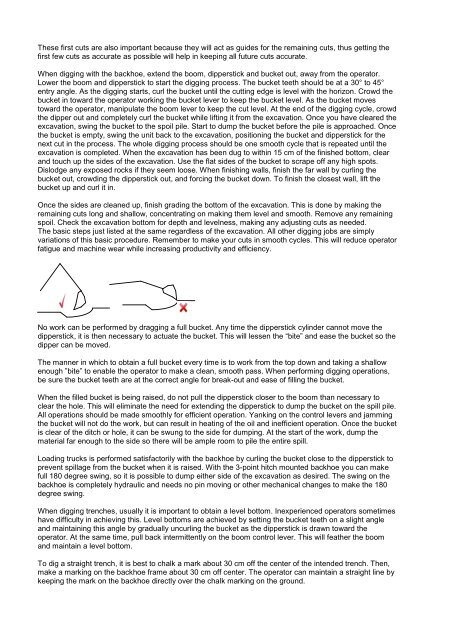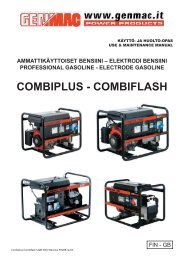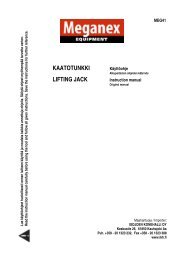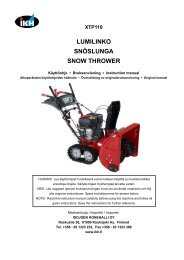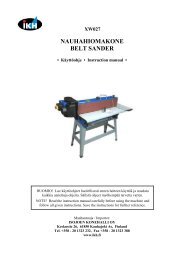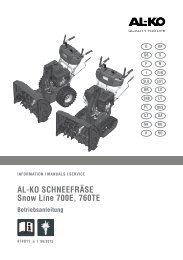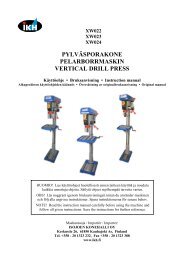INSTRUCTION MANUAL - Virtasenkauppa.fi
INSTRUCTION MANUAL - Virtasenkauppa.fi
INSTRUCTION MANUAL - Virtasenkauppa.fi
You also want an ePaper? Increase the reach of your titles
YUMPU automatically turns print PDFs into web optimized ePapers that Google loves.
These <strong>fi</strong>rst cuts are also important because they will act as guides for the remaining cuts, thus getting the<br />
<strong>fi</strong>rst few cuts as accurate as possible will help in keeping all future cuts accurate.<br />
When digging with the backhoe, extend the boom, dipperstick and bucket out, away from the operator.<br />
Lower the boom and dipperstick to start the digging process. The bucket teeth should be at a 30° to 45°<br />
entry angle. As the digging starts, curl the bucket until the cutting edge is level with the horizon. Crowd the<br />
bucket in toward the operator working the bucket lever to keep the bucket level. As the bucket moves<br />
toward the operator, manipulate the boom lever to keep the cut level. At the end of the digging cycle, crowd<br />
the dipper out and completely curl the bucket while lifting it from the excavation. Once you have cleared the<br />
excavation, swing the bucket to the spoil pile. Start to dump the bucket before the pile is approached. Once<br />
the bucket is empty, swing the unit back to the excavation, positioning the bucket and dipperstick for the<br />
next cut in the process. The whole digging process should be one smooth cycle that is repeated until the<br />
excavation is completed. When the excavation has been dug to within 15 cm of the <strong>fi</strong>nished bottom, clear<br />
and touch up the sides of the excavation. Use the flat sides of the bucket to scrape off any high spots.<br />
Dislodge any exposed rocks if they seem loose. When <strong>fi</strong>nishing walls, <strong>fi</strong>nish the far wall by curling the<br />
bucket out, crowding the dipperstick out, and forcing the bucket down. To <strong>fi</strong>nish the closest wall, lift the<br />
bucket up and curl it in.<br />
Once the sides are cleaned up, <strong>fi</strong>nish grading the bottom of the excavation. This is done by making the<br />
remaining cuts long and shallow, concentrating on making them level and smooth. Remove any remaining<br />
spoil. Check the excavation bottom for depth and levelness, making any adjusting cuts as needed.<br />
The basic steps just listed at the same regardless of the excavation. All other digging jobs are simply<br />
variations of this basic procedure. Remember to make your cuts in smooth cycles. This will reduce operator<br />
fatigue and machine wear while increasing productivity and ef<strong>fi</strong>ciency.<br />
No work can be performed by dragging a full bucket. Any time the dipperstick cylinder cannot move the<br />
dipperstick, it is then necessary to actuate the bucket. This will lessen the “bite” and ease the bucket so the<br />
dipper can be moved.<br />
The manner in which to obtain a full bucket every time is to work from the top down and taking a shallow<br />
enough ”bite” to enable the operator to make a clean, smooth pass. When performing digging operations,<br />
be sure the bucket teeth are at the correct angle for break-out and ease of <strong>fi</strong>lling the bucket.<br />
When the <strong>fi</strong>lled bucket is being raised, do not pull the dipperstick closer to the boom than necessary to<br />
clear the hole. This will eliminate the need for extending the dipperstick to dump the bucket on the spill pile.<br />
All operations should be made smoothly for ef<strong>fi</strong>cient operation. Yanking on the control levers and jamming<br />
the bucket will not do the work, but can result in heating of the oil and inef<strong>fi</strong>cient operation. Once the bucket<br />
is clear of the ditch or hole, it can be swung to the side for dumping. At the start of the work, dump the<br />
material far enough to the side so there will be ample room to pile the entire spill.<br />
Loading trucks is performed satisfactorily with the backhoe by curling the bucket close to the dipperstick to<br />
prevent spillage from the bucket when it is raised. With the 3-point hitch mounted backhoe you can make<br />
full 180 degree swing, so it is possible to dump either side of the excavation as desired. The swing on the<br />
backhoe is completely hydraulic and needs no pin moving or other mechanical changes to make the 180<br />
degree swing.<br />
When digging trenches, usually it is important to obtain a level bottom. Inexperienced operators sometimes<br />
have dif<strong>fi</strong>culty in achieving this. Level bottoms are achieved by setting the bucket teeth on a slight angle<br />
and maintaining this angle by gradually uncurling the bucket as the dipperstick is drawn toward the<br />
operator. At the same time, pull back intermittently on the boom control lever. This will feather the boom<br />
and maintain a level bottom.<br />
To dig a straight trench, it is best to chalk a mark about 30 cm off the center of the intended trench. Then,<br />
make a marking on the backhoe frame about 30 cm off center. The operator can maintain a straight line by<br />
keeping the mark on the backhoe directly over the chalk marking on the ground.


